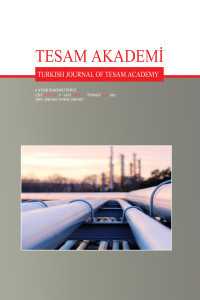Döviz Kurları ve Petrol Fiyatlarının Türk Dış Ticaretine Etkisi
Döviz kuru ve petrol fiyatları bir ülkenin ticaret performansında önemli bir rol oynar. İster dışsal bir şok, isterse de bir politika sonucunda belirlensin, yerli para biriminin nispi değeri ve dalgalanmaları uluslararası ticaret, ödemeler dengesi ve tüm ekonomik performans üzerinde önemli bir etki yaratmaktadır. Bu çalışma, Türkiye’ nin dış ticaretinin 2010-2016 dönemi için Ameirka ve Euro Bölgesi için ayrı olarak analiz etmeyi amaçlamaktadır. Üç farklı regresyon tahmini yapılmıştır. Birincisi, Türkiye-Euro bölgesi dış ticareti üzerinde Euro’ nun etkisini analiz etmek için, ikincisi, Türkiye-ABD dış ticareti üzerinde Amerikan dolarının etkisini belirlemek için ve üçüncüsü, Türkiye-Rusya arasındaki petrol icareti üzerine petrol fiyatlarının etkisini incelemek içindir. Bu çalışma için panel regresyon teknikleri kullanılmıştır. Sonuç olarak, ülkeler döviz kurlarını sadece ticari partnerleri içind değil, aynı zamanda rakipleri için de bir montirör olarak görmeleri gerektiği sonucuna varılmıştır.
Anahtar Kelimeler:
Döviz Kuru, Petrol Fiyatları, Dış Ticaret, Panel Data, Panel Data Tahmin Teknikler
Effects of Exchange Rates and Oil Prices on Turkish Foreign Trade
Exchange rate and oil prices play an important role in a country’s trade performance. Whether determined by exogenous shocks or by a policy, the relative valuations of currencies and their volatility often have important impact on international trade, the balance of payments and overall economic performance. This study aims to analyze Turkey’s foreign trade with Euro Area and USA separately between 2010-2016 time periods. We have estimated three different regressions. First one is for analyzing the effects of euro on Turkey-Euro area foreign trade, the second one is for determining the effects of US dollar on Turkey-USA foreign trade and the third one is for examining the effects of oil prices on oil trade between Turkey and Russia. For this study we use the panel regression techniques. As a result we can conclude that countries should monitor their exchange rate relative not only to that of their trading partners but also in relation to that of their competitors.
Keywords:
Exchange Rate, Oil Prices, Foreign Trade, Panel Data, Panel Estimation Techniques,
___
- Abrams, R.K. (1980). Internaional Tade Flows under Flexible Exchange Rates. Economic Review, Mar, 65(3), 3-10.
- Amano, R.A., and Norden, S. (1998). Oil Prices and the Rise and Fall of the U.S. Real Exchange Rate. Journal of international Money and Finance, 17, 299-316.
- Baldwin, R. (1988). Hysteresis in Import Prices: The Beachhead Effect. American Economic Review. 78(4), 773-85.
- Baron, D. (1976). Flexible Exchange Rates, Forward Markets, and the Level of Trade. American Economic Review. 66, 253-66.
- Bown, C., (2010). Global Anti-dumping Database available at: http://econ.worldbank.org/ttbd/gad/
- Broda C. and John R., (2010). Identifying the Relationship between Trade and Exchange Rate Volatility. NBER Chapters, in: Commodity Prices and Markets, East Asia Seminar on Economics. 20: National Bureau of Economic Research, Inc., 79-110.
- Chen, S.S. and Hsu, K.W. (2012). Reverse Globalization: Does High Oil Price Volatility Discourage International Trade?. Energy Economics, 34 (5), 1634–1643.
- Clark, P., (1973), Uncertainty, Exchange Rate Risk, and the Level of International Trade. Western Economic Journal, 1, 303-13.
- Cushman, D. (1983). The Effects of Real Exchange Risk on International Trade. Journal of International Economics, 15, 45-63.
- Engin, B (2007). 1994-2004 Döneminde Döviz Kuru Volatilitesinin Türk Tekstil ve Konfeksiyon İhracatı ve Karlılığı Üzerindeki Etkileri. Sosyal Bilimler Dergisi, 1, 53-64.
- Ethier, W. (1973). International Trade and the Forward Exchange Market. American Economic Review, 63(3), 494-503.
- Feenstra, R.and Taylor, A. (2014). Essentials of International Economics. 3.ed., Worth Publishers, New York.
- Franke, G. (1991). Exchange Rate Volatility and International Trading Strategy. Journal of International Money and Finance, 10, 292-307.
- Frieden, J. (1997). The Politics of Exchange Rates. Mexico, 1994. Anatomy of an Emerging Market Crash (Sebastian Edwards, Moises Naim, Eds.). Carnegie Endowment for International Peace.
- Friedman, M. (1953). The Case for Flexible Exchange Rates. In Essays in Positive Economics, 157-203.
- Froot, K. and Klemperer, P. (1989). Exchange Rate Pass-Through When Market Share Matters. American Economic Review. 79(4), 637-54.
- Goldberg, Pinelopi K. and Michael, M. K. (1997). Goods Prices and Exchange Rates: What Have We Learned? Journal of Economic Literature 35(3), 1243-1272.
- Klein, M. and Jay S. (2006). Fixed exchange rates and trade. Journal of International Economics 70(2), 359-383.
- Krugman, P. (1989). The Case for Stabilizing Exchange Rates. Oxford Review of Economic Policy, Oxford University Press. 5(3), 61-72.
- Mundell, R. A. (1961). A Theory of Optimal Currency Areas. American Economic Review, 51(4), 657-665.
- Mussa, M. (1984). The Theory of Exchange Rate Determination. in J.F.O. Bilson and R.C. Marston. eds., Exchange rate theory and practice (University of Chicago Press, Chicago, IL), 13-58.
- Öztürk, İ. ve Acaravcı, A. (2003). The Effects of Exchange Rate Volatility on the Turkish Export: An Empiricial Investigation. Review of Social, Economic and Business Studies, 2, 197¬206.
- Öztürk, M.B.E ve Sancar, E. (2018). OPEC’s Dwidling Influence on Oil Prices. Social Siences Studies in Turkey, Eyüp Sarıtaş, Eds., Trafford Publishing, New York, pp.620-420.
- Peree, E. and Alfred, S. (1989). Exchange Rate Uncertainty and Foreign Trade. European Economic Review 33, 1241-1264.
- Qureshi, M. and Charalambos, T. (2010). The Empirics of Exchange Rate Regimes and Trade. Words vs. Deeds, IMF Working Paper WP. 10/48.
- Sercu, P. and Vanhulle, C. (1992). Exchange Rate Volatility, International Trade and the Value of Exporting Firms. Journal of Banking and Finance. 16, 155-82.
- Seyidoğlu, H. (2015). Uluslararası İktisat Teori Politika ve Uygulama, 20. bs., İstanbul.
- Staiger, R. and Alan, S. (2010). Currency manipulation and World Trade World Trade Review 9(4), 583-627.
- Şengönül, A. Karadaş, H.A. Koşaroğlu, Ş.M. (2018). Petrol Fiyatlarınınİhracat Üzerindeki Etkisi. Yönetim ve Ekonomi, 25(2), 335-349.
- Tenreyro, S. (2007). On The Trade Impact of Nominal Exchange Rate Volatility. Journal of Development Economics, 82(2), 485-508.
- Zhao, L. and Yuqing, X. (2006). Global Production and Currency Devaluation. Review of International Economics, 14, 202-211.
- http://www.johnromalis.com/wp-content/uploads/2012/07/erv_trade.pdf
- ISSN: 2148-2462
- Yayın Aralığı: Yılda 2 Sayı
- Başlangıç: 2014
- Yayıncı: TESAM Ekonomik Siyasal ve Stratejik Araştırmalar Merkezi Derneği
